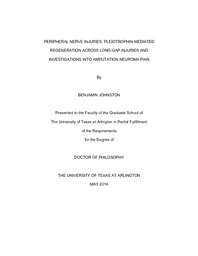
ATTENTION: The works hosted here are being migrated to a new repository that will consolidate resources, improve discoverability, and better show UTA's research impact on the global community. We will update authors as the migration progresses. Please see MavMatrix for more information.
Show simple item record
| dc.contributor.author | Johnston, Benjamin | |
| dc.date.accessioned | 2017-05-31T19:24:08Z | |
| dc.date.available | 2017-05-31T19:24:08Z | |
| dc.date.submitted | January 2014 | |
| dc.identifier.other | DISS-12697 | |
| dc.identifier.uri | http://hdl.handle.net/10106/26687 | |
| dc.description.abstract | Peripheral nerve injuries can be a chronic clinical challenge for patients. Long recovery periods, functional deficits, and neuropathic pain all complicate healing. Although peripheral nerves are able to regenerate, most gap nerve injuries are repaired by autograft, which induces a secondary injury and provides suboptimal recovery of function. This work provides insights into the use of Pleiotrophin (PTN) to bridge long-gap injures and assess the functional recovery of the common peroneal nerve (CPN) injury model. In addition to regeneration strategies, a painful neuroma-blocking conduit was developed to help patients with amputation neuromas. Lastly, this work addresses the unusual phenomenon of radio frequency (RF) wave elicited neuroma pain. In vivo and in vitro testing indicates a mechanism by which RF-stimulus elicits pain. | |
| dc.description.sponsorship | Romero-Ortega, Mario | |
| dc.language.iso | en | |
| dc.publisher | Biomedical Engineering | |
| dc.title | Peripheral Nerve Injuries: Pleiotrophin-mediated Regeneration Across Long-gap Injuries And Investigations Into Amputation Neuroma Pain | |
| dc.type | Ph.D. | |
| dc.contributor.committeeChair | Romero-Ortega, Mario | |
| dc.degree.department | Biomedical Engineering | |
| dc.degree.discipline | Biomedical Engineering | |
| dc.degree.grantor | University of Texas at Arlington | |
| dc.degree.level | doctoral | |
| dc.degree.name | Ph.D. | |
Files in this item
- Name:
- Johnston_uta_2502D_12697.pdf
- Size:
- 56.04Mb
- Format:
- PDF
This item appears in the following Collection(s)
Show simple item record


